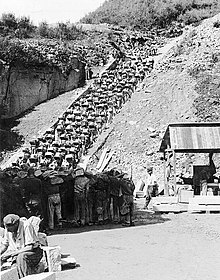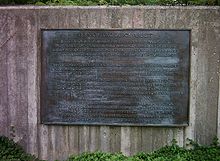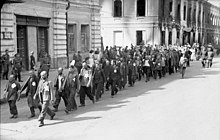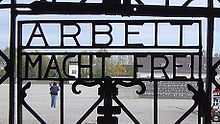
Buchenwald was a Nazi concentration camp established on Ettersberg hill near Weimar, Germany, in July 1937. It was one of the first and the largest of the concentration camps within Germany's 1937 borders. Many actual or suspected communists were among the first internees.

Neuengamme was a network of Nazi concentration camps in Northern Germany that consisted of the main camp, Neuengamme, and more than 85 satellite camps. Established in 1938 near the village of Neuengamme in the Bergedorf district of Hamburg, the Neuengamme camp became the largest concentration camp in Northwest Germany. Over 100,000 prisoners came through Neuengamme and its subcamps, 24 of which were for women. The verified death toll is 42,900: 14,000 in the main camp, 12,800 in the subcamps, and 16,100 in the death marches and bombings during the final weeks of World War II. Following Germany's defeat in 1945, the British Army used the site as an internment camp for SS and other Nazi officials. In 1948, the British transferred the land to the Free Hanseatic City of Hamburg, which summarily demolished the camp's wooden barracks and built in its stead a prison cell block, converting the former concentration camp site into two state prisons operated by the Hamburg authorities from 1950 to 2004. Following protests by various groups of survivors and allies, the site now serves as a memorial. It is situated 15 km southeast of the centre of Hamburg.
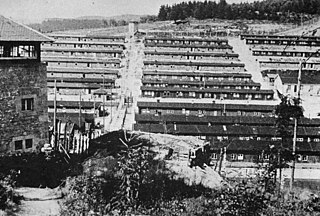
Flossenbürg was a Nazi concentration camp built in May 1938 by the SS Main Economic and Administrative Office. Unlike other concentration camps, it was located in a remote area, in the Fichtel Mountains of Bavaria, adjacent to the town of Flossenbürg and near the German border with Czechoslovakia. The camp's initial purpose was to exploit the forced labor of prisoners for the production of granite for Nazi architecture. In 1943, the bulk of prisoners switched to producing Messerschmitt Bf 109 fighter planes and other armaments for Germany's war effort. Although originally intended for "criminal" and "asocial" prisoners, after Germany's invasion of the Soviet Union, the camp's numbers swelled with political prisoners from outside Germany. It also developed an extensive subcamp system that eventually outgrew the main camp.

Oswald Ludwig Pohl was a German SS functionary during the Nazi era. As the head of the SS Main Economic and Administrative Office and the head administrator of the Nazi concentration camps, he was a key figure in the Final Solution, the genocide of the European Jews. After the war, Pohl went into hiding; he was apprehended in 1946. Pohl stood trial in 1947, was convicted of crimes against humanity, and sentenced to death. After repeatedly appealing his case, he was executed by hanging in 1951.

A labor camp or work camp is a detention facility where inmates are forced to engage in penal labor as a form of punishment. Labor camps have many common aspects with slavery and with prisons. Conditions at labor camps vary widely depending on the operators. Convention no. 105 of the United Nations International Labour Organization (ILO), adopted internationally on 27 June 1957, abolished camps of forced labor.
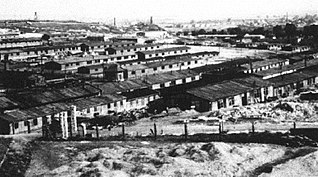
The German camps in occupied Poland during World War II were built by the Nazis between 1939 and 1945 throughout the territory of the Polish Republic, both in the areas annexed in 1939, and in the General Government formed by Nazi Germany in the central part of the country (see map). After the 1941 German attack on the Soviet Union, a much greater system of camps was established, including the world's only industrial extermination camps constructed specifically to carry out the "Final Solution to the Jewish Question".
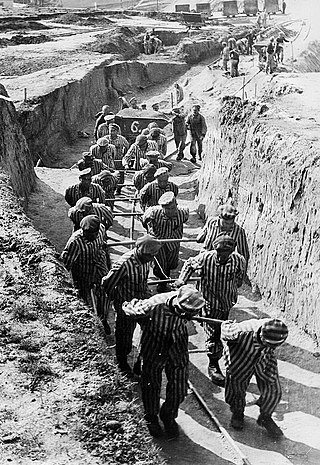
From 1933 to 1945, Nazi Germany operated more than a thousand concentration camps, including subcamps on its own territory and in parts of German-occupied Europe.
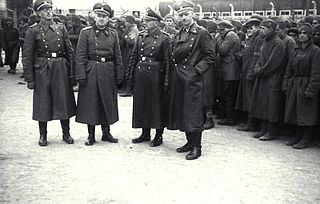
SS-Totenkopfverbände was the Schutzstaffel (SS) organization responsible for administering the Nazi concentration camps and extermination camps for Nazi Germany, among similar duties. While the Totenkopf was the universal cap badge of the SS, the SS-TV also wore this insignia on the right collar tab to distinguish itself from other SS formations.

Martin Gottfried Weiss, alternatively spelled Weiß, was the commandant of the Dachau concentration camp in 1945 at the time of his arrest. He also served from April 1940 until September 1942 as the commandant of Neuengamme concentration camp, and later, from November 1943 until May 1944, as the fourth commandant of Majdanek concentration camp. He was executed for war crimes.
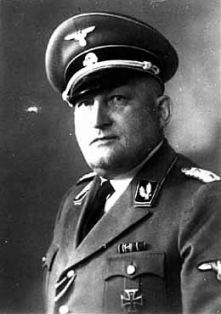
Richard Glücks was a high-ranking German Nazi official in the SS. From November 1939 until the end of World War II, he was Concentration Camps Inspector (CCI), which became Amt D: Konzentrationslagerwesen under the WVHA in Nazi Germany. As a direct subordinate of Heinrich Himmler, he was responsible for the forced labour of the camp inmates and was also the supervisor for the medical practices in the camps, ranging from human experimentation to the implementation of the "Final Solution", in particular the mass murder of inmates with Zyklon B gas. After Germany capitulated, Glücks committed suicide by swallowing a potassium cyanide capsule.

The SS Main Economic and Administrative Office was a Nazi organization responsible for managing the finances, supply systems and business projects of the Allgemeine-SS. It also ran the concentration camps and was instrumental in the implementation of the Final Solution through such subsidiary offices as the Concentration Camps Inspectorate and SS camp guards.

Soviet prisoners of war (POWs) held by Nazi Germany and primarily in the custody of the German Army, were starved and subjected to deadly conditions. Of nearly six million that were captured, around 3 million died during their imprisonment.

The use of slave and forced labour in Nazi Germany and throughout German-occupied Europe during World War II took place on an unprecedented scale. It was a vital part of the German economic exploitation of conquered territories. It also contributed to the mass extermination of populations in occupied Europe. The Germans abducted approximately 12 million people from almost twenty European countries; about two thirds came from Central Europe and Eastern Europe. Many workers died as a result of their living conditions – extreme mistreatment, severe malnutrition and abuse were the main causes of death. Many more became civilian casualties from enemy (Allied) bombing and shelling of their workplaces throughout the war. At the peak of the program the forced labourers constituted 20% of the German work force. Counting deaths and turnover, about 15 million men and women were forced labourers at one point during the war.

The Trawniki concentration camp was set up by Nazi Germany in the village of Trawniki about 40 kilometres (25 mi) southeast of Lublin during the occupation of Poland in World War II. Throughout its existence the camp served a dual function. It was organized on the grounds of the former Polish sugar refinery of the Central Industrial Region, and subdivided into at least three distinct zones.

Salaspils camp was established at the end of 1941 at a point 18 km (11 mi) southeast of Riga (Latvia), in Salaspils. The Nazi bureaucracy drew distinctions between different types of camps. Officially, it was the Salaspils Police Prison and Re-Education Through Labor Camp. It was also known as camp Kurtenhof after the German name for the city of Salaspils.

The Concentration Camps Inspectorate (CCI) or in German, IKL was the central SS administrative and managerial authority for the concentration camps of the Third Reich. Created by Theodor Eicke, it was originally known as the "General Inspection of the Enhanced SS-Totenkopfstandarten", after Eicke's position in the SS. It was later integrated into the SS Main Economic and Administrative Office as "Amt D".
German Equipment Works was a Nazi German defense contractor with headquarters in Berlin during World War II, owned and operated by the Schutzstaffel (SS). It consisted of a network of requisitioned factories and camp workshops across German-occupied Europe exploiting the prisoner slave labour from Nazi concentration camps and the Jewish ghettos in German-occupied Poland. DAW outfitted the German military with boots, uniforms and materials on the eastern front at a windfall profit, and provided wood and metal supplies, as well as reconstruction work on railway lines and freight trains.
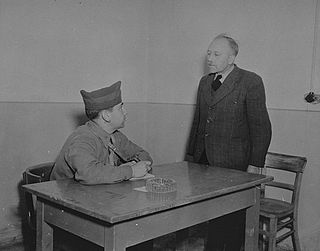
Berga an der Elster was a subcamp of the Buchenwald concentration camp. The Berga forced labour camp was located on the outskirts of the village of Schlieben. Workers were supplied by Buchenwald concentration camp and from a prisoner-of-war camp, Stalag IX-B; the latter contravened the provisions of the Third Geneva Convention and the Hague Treaties. Many prisoners died as a result of malnutrition, sickness, and beatings, including 73 American POWs.

Forced labour was an important and ubiquitous aspect of the Nazi concentration camps which operated in Nazi Germany and German-occupied Europe between 1933 and 1945. It was the harshest and most inhumane part of a larger system of forced labor in Nazi Germany.
